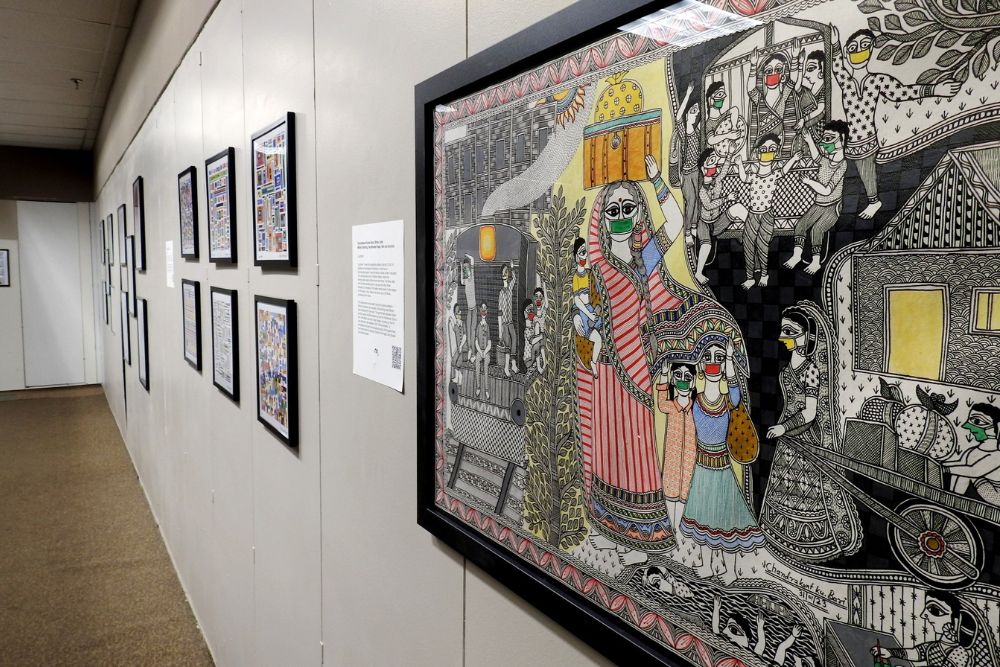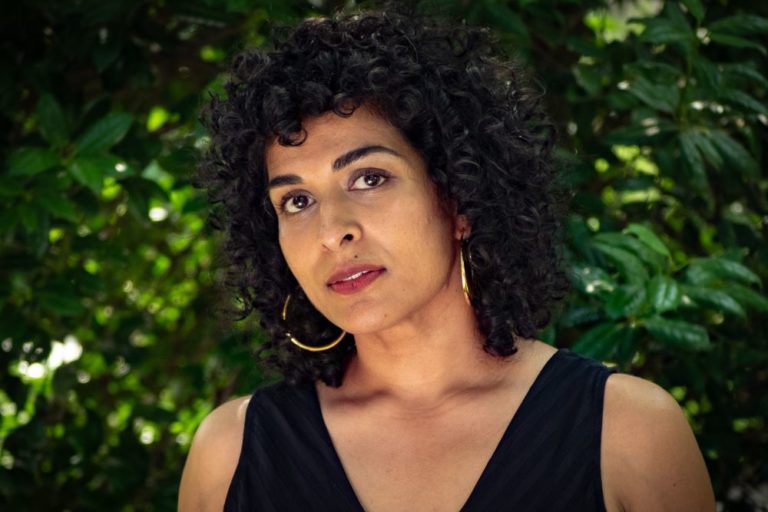An equity-based art exhibition featuring more than 200 pieces of work from all around the world, exploring the use of creativity to cope with the challenges of the COVID-19 pandemic, is opening this week at various Lansing, Michigan, locations and was three years in the making by a team led by Nancy DeJoy, Associate Professor in Michigan State University’s Department of Writing, Rhetoric, and American Cultures (WRAC), and Fatima Konare, a graduate student in WRAC.
Supported by a $3 million plus grant from the Andrew W. Mellon Foundation’s “Just Futures” Initiative, the Creativity in the Time of COVID-19: Art for Equity and Social Justice exhibit showcases the art of people from all seven continents who responded with creativity as a personal outlet and tool for social change when their communities were disproportionately affected by the pandemic. Their work reveals stories of loss, anger, and sorrow, as well as stories of generosity, strength, and resilience, and of maintaining community and personal connections, during the ongoing global crisis.

While opening up spaces for international dialogue about creativity, health, well-being, social justice, and the effects of COVID-19 on everyday life, the month-long exhibition gives people whose work is presented there a platform to assert agency in the face of oppressive social systems and to tell stories that elevate equity and social justice. The project aims to showcase the power of art to inspire, connect, and advocate for change, particularly in the face of a global pandemic.
“The idea was to try to add voices from people disproportionately affected by the pandemic and to give them a way to show how they use creativity to add to their stories.”
Nancy DeJoy, Associate Professor and Co-Curator of the Creativity in the Time of COVID-19 exhibit
“The idea was to try to add voices from people disproportionately affected by the pandemic and to give them a way to show how they use creativity to add to their stories,” DeJoy said. “I’ve done a lot of research about how creativity helps us deal with social injustice and the ways communities affected by inequity and social injustice have used creativity in their everyday lives. We envision a society in which creative acts of knowledge-making open new spaces for equity and social justice.”
As part of the exhibition, the work of more than 80 artists will be displayed throughout the month of April at the Frandor Sears Building, 3131 E. Michigan Ave., and three smaller satellite locations — Lansing Art Gallery & Education Center, 300 S. Washington Square, Suite 100; REACH Studio Art Center, 1804 S. Washington Ave.; and Impression 5 Science Center, 200 Museum Dr. The Refugee Development Center in Lansing also will display artwork for the community members who use the center.

Each venue tells a different story of creative expression in the face of systemic injustice:
- Frandor Sears Building is the flagship location for the exhibit and houses the largest collection of art of all the venues, offering a global view of creative expression during the pandemic. The exhibit at this location runs April 5-30.
- Lansing Art Gallery & Education Center showcases works from St. Louis-based and Indian-born artist Sukanya Mani, whose artwork tells the stories of domestic violence survivors during the pandemic with the goal to raise awareness of this issue and to inspire others to support survivors in their communities. This venue also features an interactive video where viewers can contribute their own voices and stories. The exhibit at this location runs April 5-29.
- REACH Studio Art Center features artwork from younger generations, giving them an opportunity to express themselves through art. The exhibit at this location runs April 3-29.
- Impression 5 Science Center will focus on the connection between science and art as fields that influence and inspire one another. The exhibit at this location runs April 5-29.
A diverse range of art forms are featured in the overall exhibition, including paintings, ceramics and glass sculptures, immersive digital displays, fiber art, poetry, and more. The collection represents a variety of voices, perspectives, and experiences during the pandemic.
Because all the pieces were created during the pandemic, many artists turned to unconventional household materials to fuel their creativity, such as a lamp made out of hundreds of pill bottles with a shade comprised of all the pill bottle tops.

“As I was hanging things, what really strikes me is how beautiful everything is together,” DeJoy said. “Like paintings next to glass art, found objects made into beautiful artifacts, the use of the coronavirus symbol in the art; and we have interactive art, like a series of long painted strips and on the back of the strips are lines of poetry that you can move around to make a poem, or you can just use all the yellow ones and see the poem the artist made.”
The Creativity in the Time of COVID-19 exhibit emerged from DeJoy’s work with students. At the beginning of the pandemic in early 2020 when all MSU classes moved to remote learning, DeJoy gave her first-year writing students the opportunity to do creative final projects instead of writing traditional essays as one way to help them deal with the stress of the pandemic.
“We envision a society in which creative acts of knowledge-making open new spaces for equity and social justice.”
Nancy DeJoy, Associate Professor and Co-Curator of the Creativity in the Time of COVID-19 exhibit
“We started to realize how important creativity was becoming as we faced the realities of COVID-19,” DeJoy said. “We wanted to find a way to invite the voices of people who were both disproportionately affected by the pandemic and using creativity in their everyday lives to tell their stories.”
A team of 28 graduate and undergraduate students joined DeJoy to work on the exhibition. Ben Lash, a graduate student in Arts, Cultural Management, and Museum Studies, led the label team.
To gather pieces and connect with artists from around the world, a survey was created and distributed in English and 9 other languages, including sign language and Braille, to extend an international invitation to submit artwork created during the pandemic. The team also reached out to art organizations from all over the world to help distribute the survey.

Pieces featured in the exhibition underwent an inclusive selection process, with a group of 26 MSU students, faculty, and staff and members of the greater Lansing community reviewing all the art submissions and deciding which pieces to include in the exhibition.
To be chosen for the exhibit, a piece had to tell a powerful story about the artist’s inner truth regarding the COVID-19 pandemic and highlight the impact of the pandemic on artists who were disproportionately affected by this global crisis.
Once the selection process was complete, DeJoy and Konare called on the MSU Translation Center to translate into various languages their communications to artists, notifying them that their pieces were selected for the exhibition. Kelsey Abner, a Supply Chain Management major, handled getting the art shipped to Michigan and stored in a local warehouse.
“In about two and half months we were able to get art from all seven continents to Lansing. It was an incredible feat, to say the least. We’ve been putting in a lot of work.”
Fatima Konare, a graduate student and Co-Curator of the Creativity in the Time of COVID-19 exhibit
“In about two and half months we were able to get art from all seven continents to Lansing,” Konare said. “It was an incredible feat, to say the least. We’ve been putting in a lot of work.”
According to Konare, the most difficult task was selecting which submissions to be featured in the exhibition.
“You put out a call that says, ‘Tell us how you were creative during COVID, especially from an equity and social justice standpoint,’” she said. “But how do we decide which ones are more creative? They’re all creative in their own way and they all tell a story of what was happening during such a tumultuous time. There were so many great pieces. I wish we could select them all.”

Fortunately, a digital archive is being created of all the pieces submitted, which will be made available after the physical exhibition is over.
At the Lansing venues, each piece in the exhibition is labeled with the artist’s story about why the art was created and more information about the piece including what materials were used. QR codes were created by STQRY for each piece to offer audio versions of the text and provide detailed descriptions of each artist and their work, and let people know if there is more art by a particular artist at one of the exhibition’s other locations. The QR code also allows the user to select a language other than English. There is also an app that accompanies the exhibit, which includes information on all the artists in the exhibition.
The Creativity in the Time of COVID-19 exhibition also has partnered with the Capital City Film Festival to hold its Exhibition Opening and Red Carpet Premiere Party together on Thursday, April 6, at 6 p.m. at the Frandor Sears Building. DeJoy, who is a social justice installation poet, is the Poet in Residence for the Capitol City Film Festival. The film festival runs April 5-15 at various locations throughout Lansing.
The Cube, a publishing and user experience research center in MSU’s Department of Writing, Rhetoric, and American Cultures, managed all the content strategy, marketing, graphic design, and website for the exhibition. DeJoy, Konare, and their team also worked with DisArt to be sure the exhibitions are accessible to all in ways that push past compliance.
For more information on the exhibition, visit the Creativity in the Time of COVID-19: Art for Equity and Social Justice website.
Written by Lynn Waldsmith


